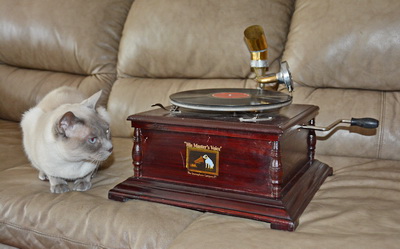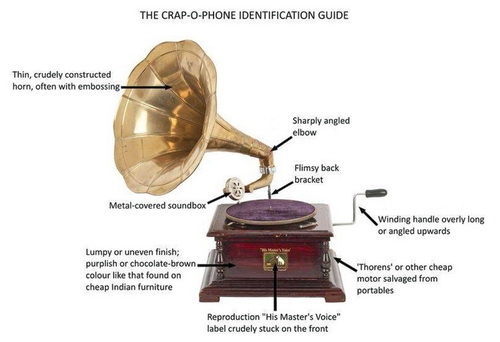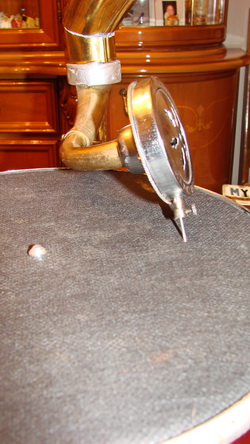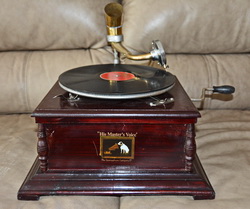|
Crap-O-Phones: Repairing, Rebuilding, or Reconstructing (?) ďThe Crap-O-PhoneĒ
by Mike Dicecco

|
|
Even Merlin suspects this is not an original Victor!
|
|
|
It all started at my office one day. I work in a home and
auto claims department and had one of our vendors
come in for a meeting; we congregated at my desk.
Sami is an accident reconstruction engineer and his
company can do some amazing calculations and predictions
based on twisted auto wreckage and highway
debris.
At my cubicle I have a few tell-tale signs that I belong to
the phonograph-collecting world (a gramophone pencil
sharpener, a ceramic jukebox, a 78 RPM & 45 RPM
record and a Blue Amberol cylinder are dead giveaways!).
During his visit, Sami suddenly noticed the little
gramophone-shaped sharpener and proudly said "I
have one of those!" (the artefacts/bait had worked
again!).
He proceeded to tell me how he had acquired his machine:
his brother is an engineer and was in Egypt doing
an assignment. He took a picture of himself in an
antique shop, sent it to Sami and in the background
was an old gramophone with a large horn. Sami was
very excited and told his brother that he really wanted
it. The talking machine was purchased for 300 Egyptian
Euros which converted to about $60 CDN and was
taken home on the airplane by Samiís brother. It was a
very thoughtful gift from one brother to another.
Sami explained how the gramophone definitely appeared
to be an original because it was bought in an
antique store, had a picture of "HMV" & Nipper on it
and even came with a 78 RPM record. It must have
been genuine because it was not working right either -
the sound was way too fast. Sure sounded like it could
be an old British-manufacture gramophone. But the
more I thought of it, the more I started to have my
doubts. When I asked what colour the horn was (bright
brass) I figured it must be a reproduction.

|
|
BEWARE THE CRAP-O-PHONE!
(Image courtesy of Mainspring Press: http://www.mainspringpress.com/crapo.html)
|
|
|
A couple of weeks later, when the machine was
brought to me for repair, it was obvious upon initial inspection
that this was indeed a "crap-o-phone". Iíve
never had the pleasure (or more like misfortune) of
working on one of these contraptions, but it meant a
lot to him, so I agreed to give it a shot. What I figured
would be a small adjustment ended up taking weeks to
complete.
Sami explained that he and his wife (both in their 30s)
were great fans of big band music. He had even proposed
to her on the dance floor while a swing band
played Glenn Millerís Moonlight Serenade! It would
mean so much to them if they were able to get this
gramophone working properly.
For those of you new to this hobby, Iíll give a brief overview
of Crap-o-phones. Most of them are assembled in
India, although apparently China has started producing
them too. The entire machine is made of poor-quality
reproduction parts, with the exception of the motor,
which is usually taken from an old portable. The units
are sold everywhere and sadly the sellers often try to
pass them off as an "antique" to unsuspecting buyers.
A quick search of e-Bay showed plenty of configurations
and asking prices, usually in the $125 to $500
range. Thereís even a supplier on e-Bay (through China)
that sells replacement parts for them. The quality is
pathetic when compared to an original Victor, which it
is loosely based on. Sadly, my experience showed that
these machines are intended to be only a decoration,
not something that would actually play music from a
78 RPM record.

|
|
Absolutely horrible tonearm tracking angle. This was one of the most challenging parts
of the repair. Note also the raised rim of the turntable which would provide only a
slipping and scuffing support to the outer rim of the record.
|
|
|
Initial Observations
Here are some of my observations on the quality (or
lack thereof):
-
The entire unit is extremely light (15-20 lbs.?), as it is
made from soft wood. The cabinet did have a nice
mahogany-type colour painted on it with little fake
Victor-inspired pillars in each corner. One pillar fell off
after some handling.
-
The crank opening is drilled close to the top right of
the cabinet and there is no escutcheon. I was left
with the impression that the hole was a last-minute
consideration (the rough wood fragmented opening
on the interior of the cabinet was the tell-tale sign). It
was apparent that the position of the crank opening
was left until the final assembly so as to accept whatever
motor happened to be available to fit into the
cabinet (refer to photo).
-
The motor board has no support bracket to keep it
open while working on the motor. The two hinges
used for the motor board were heavily rusted,
obviously being pulled from something else (hey, it saves
money and makes it look antique!).
-
Even the crank was an obvious reproduction Ė what
passed for the crankís handle was made out of black
plastic that was solidly pressed into place and never
designed to rotate as the motor was being wound.
-
The platter was odd. It was covered in some thin
black cloth material and had a crimped rim around
the edge to hold it together (this crimped rim also
provided a means for the brake to rub against). Unfortunately,
the rim was raised so that when a record
was placed upon it, the disc was actually sitting up on
the raised metal rim and not on the platter felt. The
end result is that there is no contact with, or support
from, the felt while the platter is being turned: the
only contact is with the crimped metal Ė any slippage
on this crimping would certainly scuff the outer portion
of the disc. This sort of defeats the purpose of
putting cloth on the turntable!
-

|
|
Side view of the tonearm shows the crudely cast back bracket, with a machine
screw holding it all together. Note that the soundbox is at such a poor setting
that it would rub on the record (preventing the needle from contacting the disc).
|
|
|
The back bracket and tone-arm were unfortunately
the worst part of this forgery and had very poor quality.
The bracket appeared to be crudely cast of pot
metal and, instead of a pin (and spring) to hold the
tone-arm in place, they used a long metal screw
through the arm! I had to be very careful when working
on or around it so as to not cause breakage as it
appeared quite fragile (refer to photo).
-
The horn elbow was a paper-thin brassy material held
together with solder. As I did not have the horn Iím
not able to comment on its quality but there is no reason
to suspect that it is any better than the rest of
the unit.
-
The opening in the bracket was about ľ" too large
for the tone-arm so that (coupled with the loose metal
screw) caused the arm to heavily lean sideways as
it tried to track a record. It was NOT perpendicular to
the disc. This tone-arm set-up proved to be the hardest
part to remedy.
-
There are no screws holding the motor board closed.
The only part keeping it all together was the crank.
The water decal on the front is quite deceptive with a
nice picture of Nipper and a Victor stating "His Masterís
Voice". This is obvious copyright infringement but
probably hard to enforce in a third-world country.

|
|
Double-spring bed-and-plate motor (with no lubrication) appears to have
come from an old portable. Note the badly rusty springs on the left side of the lid.
|
|
|
"You do not repair a Crap-o-phone ó you re-engineer it!"
There were many issues encountered in trying to make
this specimen play a record. Sometimes I had my
doubts that the machine would ever be anything more
than an ornament. Here is a list of problems that I encountered,
along with my solutions:
-
MOTOR: The motor appears to be out of an old portable
machine. Itís a two-spring bed-and-plate type of
configuration that had seen absolutely no lubrication!
It appears to have been degreased (for appearances)
but was never re-greased afterward. It ran with a little
vibration and would barely make it through one full
10" record, slowing down gradually toward the end.
After lots of lubrication and use, and a little adjusting,
its performance improved somewhat.
-
GOVERNOR: The initial problem with the machine
was that "the record sounds like chipmunks", which
meant that it was running way too fast. (Question:
how can you tell if an Indian-music 78 RPM record is
not at the right speed?) It appears that the friction
material on the governor was not properly adjusted.
Loosening the set-screw and re-positioning it did not
give the proper speed so I had to bend the actual
governor shaft so it would be closer to the governor
itself. Now there was ample adjustment room to get it
down to the proper speed. Ironically, this was the reason
that the machine was initially brought to me, and
was the easiest fault to correct.
I wonder if the initial problem came from the manner
in which the "factory" assembled it, or if the soft metal
bracket was bent from use - I suspect the latter.
-
TONE-ARM: The biggest problem turned out to be the
brass tone-arm and this required the greatest
amount of work to correct what the "factory" did not
do properly in the first place. The opening supporthole
in the back bracket was about ľ" too large for
the arm, thus allowing it to flop around as it tried
to track a record. Excessive movement was in both
the vertical and horizontal planes (not to mention the
sound vibrations that would have never made it into
the horn due to this excessive leakage).

|
|
Crude hole drilled in the side of the cabinet for the crank. There is not even an escutcheon affixed.
|
|
|
There were two cures for the tone-arm:
-
the crude machine-screw that was used to hold the arm to the
back bracket was too loose and could not be secured.
Adding a bolt to lock it in place helped control some of
the excessive play
-
somehow the gap in the back bracket had to be taken up. I used a 1 Ĺ" strip of copper-
pipe strapping to fill this area, and held it in place
with epoxy (see photo). The arm now moved smoothly
and properly in all planes and did not sag over as a
record was played. A dab of grease ensured that the
arm did not bind to the opening in the bracket. The arm
and soundbox were now more perpendicular to the record.
I was quite proud of my solution which had the
greatest impact on the end results. Nothing,
however, could fix the horrible tracking angle
error that was inherent in the original tone-arm design.
This would be something that the owner would have to
live with. Another issue with the tone-arm was its
miniscule interior diameter which would certainly not
allow much sound volume to transmit to the horn.
These two issues could not be corrected unless the
entire tone-arm was changed, and this was not an option
(since a proper Victor tone-arm would cost more
than the whole machine was worth Ė if it would even
fit!)
-

|
|
Repaired: top of the tonearm looking inside. The copper strip takes up
much of the slack and helps to correct the tonearm tracking angle greatly.
It is still not perfect, but a huge improvement.
|
|
|
SOUNDBOX: The reproducer is a very light affair, being
made of tin (front and back) with an aluminum diaphragm.
Engraved on it are the words "Sound Box. His
Masterís Voice". The diaphragm was aluminum and
actually did not sound that bad. Having a light soundbox
soundbox also made it easier on the weak motor to make it
to the end of a record (steel needles also lasted longer).
This unit had two main problems:
-
The hole for the needle was not deep enough. The
end result was that the soundbox was lifted too
high off the record which made the already bad
tracking angle all the more pronounced. The solution
was to use a small drill-bit to deepen the needle
holder by about 1/8Ē so that the steel needle fit
more fully into the needle-bar.
-
The second issue had to do with the way
the soundbox was attached to the skimpy tone-arm
- it was only a weak press fit, held on by a flimsy
rubber gasket. If the soundbox was positioned
properly at the start of a record, it would slowly
move out of position as the record played with the
end result being that the reproducer body touched
the record instead of the needle. The fix was to drill
a hole through the flanged edge of the soundbox,
tap threads into the hole and attach a screw to
hold it in place on the tone-arm. A corresponding
indentation was made in the tonearm to help ensure
that it was kept in the proper location. Problem
solved!
Conclusion
Getting this machine to play a 78 RPM record proved
to be a much bigger challenge than I ever initially envisioned.
It became clear that this "gramophone" was
intended to be only a decoration and I doubt that it
worked to any degree after leaving the
"factory" (especially considering all the corrections I
have listed above).

|
|
Repaired: the various tips described in the article resulted in a vastly improved tonearm tracking
angle (with improved sound and less record wear). The soundbox is no longer rubbing on the record,
and is firmly held in place. Success!
|
|
|
After working on this unit I was left with a new appreciation
of the quality and workmanship that went into
most "real"Ē antique gramophones Ė something that
obviously cannot be economically duplicated today.
The original reported problem was that the speed was
too fast (on the one Indian 78 that came with it). Correcting
the speed was actually one of the easiest aspects
of the repair. My friend Sami really wanted to
hear some big band records on his prized
"gramophone", so I took up the challenge and he was
very happy with the results.
Is a "crap-o-phone" a piece of garbage that should never
be bothered with in the first place? I donít think so.
Iím sure most non-collectors would balk at paying
$1000 or more for a "real" Victor (or other brand) outside-
horn gramophone (even though most of us at
CAPS would probably have no trouble justifying it to
ourselves, if not our wives).
For $60 Sami got a machine that is a conversation
piece in his living room and he is now able to actually
play some big band records which I provided. So I
guess that these poor-quality knock-offs have value to
some degree. I hope that some of my remedies may
assist others in the future, should they have the misfortune
of acquiring a Crap-o-phone (or repairing for
someone else). Just please donít ask me to work on
another one!
(All photographs courtesy of the author)
|